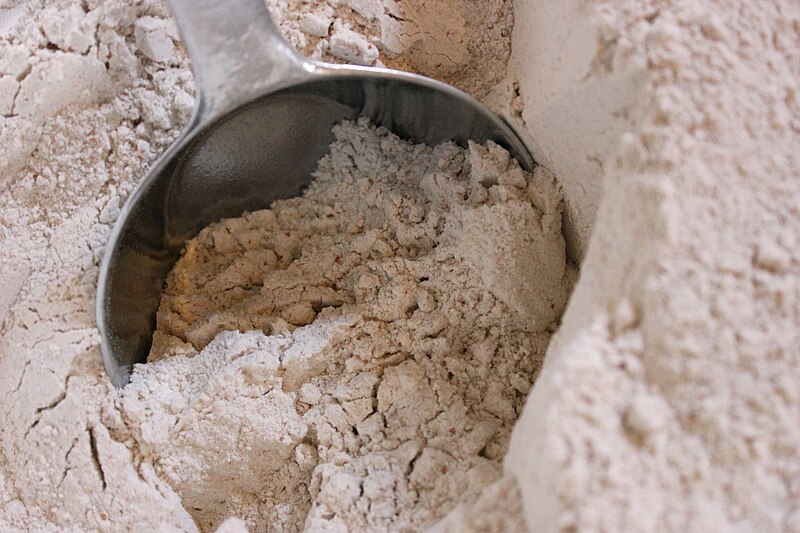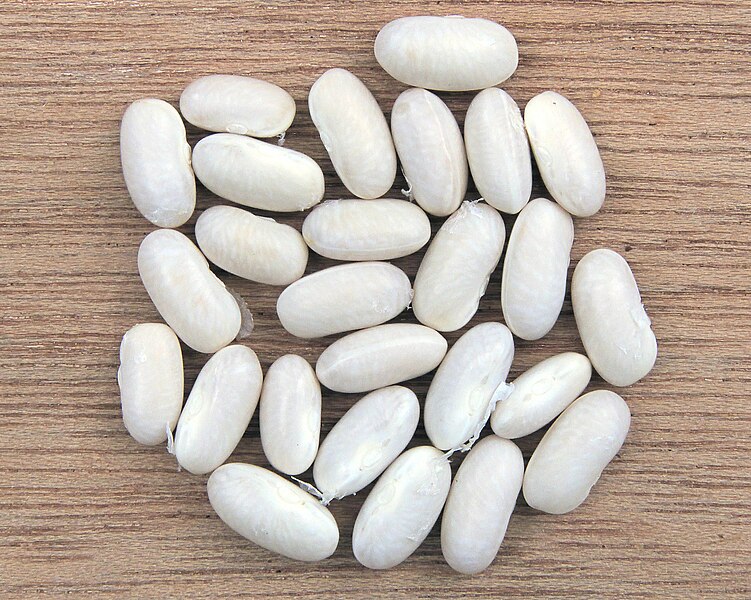Whole Wheat Flour vs. White Beans
Nutrition comparison of Whole Wheat Flour and White Beans
Ever wonder how your favorite foods stack up against each other in terms of nutrition?
We compared the nutritional contents of
whole wheat flour
versus
white beans
(100g each)
below using 2020 USDA and NIH data[1].
For a quick recap of significant nutrients and differences in whole wheat flour and white beans:
- Both whole wheat flour and white beans are high in calories, dietary fiber, iron and potassium.
- White bean is an excellent source of calcium.
- Whole wheat flour has more thiamin, riboflavin, niacin, pantothenic acid and Vitamin B6, however, white bean contains more folate.
- Whole wheat flour is a great source of protein.
USDA sources for nutritional information: Whole Wheat Flour (Wheat flour, whole-grain, soft wheat) and White Beans (Beans, white, mature seeds, canned) . Have a correction or suggestions? Shoot us an email.
Calories and Carbs
calories
Both whole wheat flour and white beans are high in calories. Whole wheat flour has 191% more calories than white bean - whole wheat flour has 332 calories per 100 grams and white bean has 114 calories.
For macronutrient ratios, whole wheat flour is lighter in protein, heavier in carbs and similar to white beans for fat. Whole wheat flour has a macronutrient ratio of 11:84:5 and for white beans, 25:73:2 for protein, carbohydrates and fat from calories.
Macro Ratios from Calories:
| Whole Wheat Flour | White Beans | |
|---|---|---|
| Protein | 11% | 25% |
| Carbohydrates | 84% | 73% |
| Fat | 5% | 2% |
| Alcohol | ~ | ~ |
carbohydrates
Whole wheat flour is high in carbohydrates and white bean has 72% less carbohydrates than whole wheat flour - whole wheat flour has 74.5g of total carbs per 100 grams and white bean has 21.2g of carbohydrates.
dietary fiber
Both whole wheat flour and white beans are high in dietary fiber. Whole wheat flour has 173% more dietary fiber than white bean - whole wheat flour has 13.1g of dietary fiber per 100 grams and white bean has 4.8g of dietary fiber.
sugar
Whole wheat flour and white beans contain similar amounts of sugar - whole wheat flour has 1g of sugar per 100 grams and white bean has 0.29g of sugar.
Protein
protein
Whole wheat flour is a great source of protein and it has 32% more protein than white bean - whole wheat flour has 9.6g of protein per 100 grams and white bean has 7.3g of protein.
Fat
saturated fat
Both whole wheat flour and white beans are low in saturated fat - whole wheat flour has 0.43g of saturated fat per 100 grams and white bean has 0.07g of saturated fat.
Vitamins
Vitamin A
Whole wheat flour and white beans contain similar amounts of Vitamin A - whole wheat flour has 2.7ug of Vitamin A per 100 grams and white bean does not contain significant amounts.
Vitamin E
Whole wheat flour and white beans contain similar amounts of Vitamin E - whole wheat flour has 0.53mg of Vitamin E per 100 grams and white bean has 0.79mg of Vitamin E.
Vitamin K
Whole wheat flour and white beans contain similar amounts of Vitamin K - whole wheat flour has 1.9ug of Vitamin K per 100 grams and white bean has 2.9ug of Vitamin K.
The B Vitamins
Whole wheat flour has more thiamin, riboflavin, niacin, pantothenic acid and Vitamin B6, however, white bean contains more folate.
| Whole Wheat Flour | White Beans | |
|---|---|---|
| Thiamin | 0.297 MG | 0.096 MG |
| Riboflavin | 0.188 MG | 0.037 MG |
| Niacin | 5.347 MG | 0.113 MG |
| Pantothenic acid | 1.011 MG | 0.185 MG |
| Vitamin B6 | 0.191 MG | 0.075 MG |
| Folate | 28 UG | 65 UG |
Minerals
calcium
White bean is an excellent source of calcium and it has 121% more calcium than whole wheat flour - whole wheat flour has 33mg of calcium per 100 grams and white bean has 73mg of calcium.
iron
Both whole wheat flour and white beans are high in iron. Whole wheat flour has 24% more iron than white bean - whole wheat flour has 3.7mg of iron per 100 grams and white bean has 3mg of iron.
potassium
Both whole wheat flour and white beans are high in potassium. White bean has 15% more potassium than whole wheat flour - whole wheat flour has 394mg of potassium per 100 grams and white bean has 454mg of potassium.
Customize your serving size
The comparison below is by weight, but sometimes 100g isn't that intuitive of a measurement for food. View a custom portion comparison (e.g. cups, oz, package).
You can try adding or subtracting the amount of either Whole Wheat Flour or White Beans .
Note: The specific food items compared are: Whole Wheat Flour (Wheat flour, whole-grain, soft wheat) and White Beans (Beans, white, mature seeds, canned) .
Whole Wheat Flour g
()
|
Daily Values (%) |
White Beans g
()
|
|||||
|---|---|---|---|---|---|---|---|
| KCAL % |
|
5% | calories | 5% |
|
KCAL % | |
| G % |
|
5% | carbohydrates | 5% |
|
G % | |
| G % |
|
5% | dietary fiber | 5% |
|
G % | |
| G | 5% | sugar | 5% | G | |||
| G % |
|
5% | total fat | 5% |
|
G % | |
| G % |
|
5% | saturated fat | 5% |
|
G % | |
| G | 5% | monounsaturated fat | 5% | G | |||
| G | 5% | polyunsaturated fat | 5% | G | |||
| G | 5% | trans fat | 5% | G | |||
| MG | 5% | cholesterol | 5% | MG | |||
| MG % |
|
5% | sodium | 5% |
|
MG % | |
| 5% | Vitamins and Minerals | 5% | |||||
| UG % |
|
5% | Vitamin A | 5% |
|
UG % | |
| MG % |
|
5% | Vitamin C | 5% |
|
MG % | |
| IU % |
|
5% | Vitamin D | 5% |
|
IU % | |
| MG % |
|
5% | calcium | 5% |
|
MG % | |
| MG % |
|
5% | iron | 5% |
|
MG % | |
| MG % |
|
5% | magnesium | 5% |
|
MG % | |
| MG % |
|
5% | potassium | 5% |
|
MG % | |
| MG % |
|
5% | thiamin (Vit B1) | 5% |
|
MG % | |
| MG % |
|
5% | riboflavin (Vit B2) | 5% |
|
MG % | |
| MG % |
|
5% | niacin (Vit B3) | 5% |
|
MG % | |
| MG % |
|
5% | Vitamin B6 | 5% |
|
MG % | |
| MG % |
|
5% | pantothenic acid (Vit B5) | 5% |
|
MG % | |
| UG % |
|
5% | folate (Vit B9) | 5% |
|
UG % | |
| UG % |
|
5% | Vitamin B12 | 5% |
|
UG % | |
| MG % |
|
5% | Vitamin E | 5% |
|
MG % | |
| UG % |
|
5% | Vitamin K | 5% |
|
UG % | |
| G % |
|
5% | protein | 5% |
|
G % | |
| UG % |
|
5% | biotin (Vit B7) | 5% |
|
UG % | |
| MG % |
|
5% | choline | 5% |
|
MG % | |
| MG % |
|
5% | chlorine | 5% |
|
MG % | |
| UG % |
|
5% | chromium | 5% |
|
UG % | |
| MG % |
|
5% | copper | 5% |
|
MG % | |
| UG % |
|
5% | fluoride | 5% |
|
UG % | |
| UG % |
|
5% | iodine | 5% |
|
UG % | |
| MG % |
|
5% | manganese | 5% |
|
MG % | |
| UG % |
|
5% | molybdenum | 5% |
|
UG % | |
| MG % |
|
5% | phosphorus | 5% |
|
MG % | |
| UG % |
|
5% | selenium | 5% |
|
UG % | |
| MG % |
|
5% | zinc | 5% |
|
MG % | |
| G | 5% | Water | 5% | G | |||
| G | 5% | Starch | 5% | G | |||
| G | 5% | Alcohol | 5% | G | |||
FAQ
Does whole wheat flour or white beans contain more calories in 100 grams?Both whole wheat flour and white beans are high in calories. Whole wheat flour has 190% more calories than white bean - whole wheat flour has 332 calories in 100g and white bean has 114 calories.
Does whole wheat flour or white beans have more carbohydrates?
By weight, whole wheat flour is high in carbohydrates and white bean has 70% fewer carbohydrates than whole wheat flour - whole wheat flour has 74.5g of carbs for 100g and white bean has 21.2g of carbohydrates.
Does whole wheat flour or white beans contain more calcium?
White bean is a rich source of calcium and it has 120% more calcium than whole wheat flour - whole wheat flour has 33mg of calcium in 100 grams and white bean has 73mg of calcium.
Does whole wheat flour or white beans contain more iron?
Both whole wheat flour and white beans are high in iron. Whole wheat flour has 20% more iron than white bean - whole wheat flour has 3.7mg of iron in 100 grams and white bean has 3mg of iron.
Does whole wheat flour or white beans contain more potassium?
Both whole wheat flour and white beans are high in potassium. White bean has 20% more potassium than whole wheat flour - whole wheat flour has 394mg of potassium in 100 grams and white bean has 454mg of potassium.

